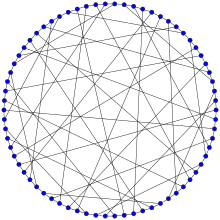Harries graph
| Harries graph | |
|---|---|

The Harries graph
|
|
| Vertices | 70 |
| Edges | 105 |
| Radius | 6 |
| Diameter | 6 |
| Girth | 10 |
| Automorphisms | 120 (S5) |
| Chromatic number | 2 |
| Chromatic index | 3 |
| Properties |
Cubic Cage Triangle-free Hamiltonian |
In the mathematical field of graph theory, the Harries graph or Harries (3-10)-cage is a 3-regular undirected graph with 70 vertices and 105 edges.
The Harries graph has chromatic number 2, chromatic index 3, radius 6, diameter 6, girth 10 and is Hamiltonian. It is also a 3-vertex-connected and 3-edge-connected non-planar cubic graph.
The characteristic polynomial of the Harries graph is
In 1972, A. T. Balaban published a (3-10)-cage graph, a cubic graph that has as few vertices as possible for girth 10. It was the first (3-10)-cage discovered but it was not unique.
The complete list of (3-10)-cage and the proof of minimality was given by O'Keefe and Wong in 1980. There exist three distinct (3-10)-cage graphs—the Balaban 10-cage, the Harries graph and the Harries–Wong graph. Moreover, the Harries–Wong graph and Harries graph are cospectral graphs.
The chromatic number of the Harries graph is 2.
The chromatic index of the Harries graph is 3.
Alternative drawing of the Harries graph.
Alternative drawing emphasizing the graph's 4 orbits.
...
Wikipedia
